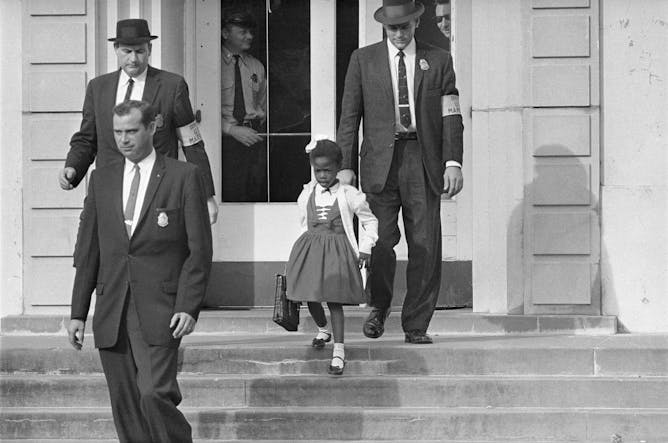|
|
|
|
On Nov. 14, 1960, at the age of 6, Ruby Bridges became the first Black child to attend William Frantz Public School and one of the first African American students to brave racist jeers and threats to desegregate a Deep South school. Her story as someone who broke down racist barriers can be glimpsed in a Kamala Harris meme that has gone viral. It shows a striding Harris casting a silhouettte of a Norman Rockwell painting of that little girl in a fluffy dress and ponytail.
What became of that historic school tells not just Bridges’ story of desegregation but also that of a “continued racism as well as efforts to dismantle and privatize public education” in the U.S., write University of Nebraska Omaha education scholar Connie L. Schaffer and her colleagues Martha Graham Viator and Meg White.
Also today:
|
Emily Schwartz Greco
Philanthropy + Nonprofits | Childhood + Parenting Editor
|

|
|

US deputy marshals escort 6-year-old Ruby Bridges outside William Frantz Public School in New Orleans in 1960.
AP Photo
Connie L. Schaffer, University of Nebraska Omaha; Martha Graham Viator, Rowan University; Meg White, Stockton University
Is the public education that Ruby Bridges fought to integrate a relic of the past?
|
Science + Technology
|
-
Catherine Lynne Troisi, University of Texas Health Science Center at Houston
Biden will begin his presidency in the midst of a global public health crisis that's already killed over 240,000 people in the US alone. His team is already planning how to get COVID-19 under control.
-
Timothy R. Tangherlini, University of California, Berkeley
Computational methods could help identify conspiracy theories as they emerge.
|
|
Politics/Election '20
|
-
Brian Grodsky, University of Maryland, Baltimore County
Each side in the bloody Nagorno-Karabakh conflict accuses the other of war crimes. Such allegations attract foreign attention and possibly intervention, but rarely lead to a peaceful solution.
-
Lincoln Mitchell, Columbia University
Trump was the first US president from New York City since Teddy Roosevelt, but he was never a hometown hero. Jubilant celebrations erupted across New York after Biden's projected win.
|
|
Health
|
-
Zack Buck, University of Tennessee
The ACA's third date with the Supreme Court was Nov. 10, and it will be months before a decision. In the meantime, however, Congress and the new president can do things to bolster the law.
-
Terri Levien, Washington State University; Anne P. Kim, Washington State University
Many people object to the added ingredients in vaccines. But pharmacists explain why those fears are unwarranted.
|
|
Ethics + Religion
|
-
Stewart Clem, Aquinas Institute of Theology
When Trump leaves the White House in January, many American evangelicals will feel that they've lost their protector in chief.
-
Mark Satta, Wayne State University
The case Fulton v. Philadelphia is about foster care. But questions over a decades-old Supreme Court ruling may have wider implications.
|
|
Environment + Energy
|
-
Erin Seekamp, North Carolina State University
With growing drought, rising seas and heavier storms, how do we protect Venice and other world treasures? The answer: creative, proactive measures that may alter them in important ways.
|
|
Economy + Business
|
-
Guo Xu, University of California, Berkeley; Abhay Aneja, University of California, Berkeley
President Wilson sanctioned segregation policies more than a century ago by targeting Black civil service workers.
|
|
From our international editions
|
-
Etain Tannam, Trinity College Dublin
The question of the Irish border after Brexit is a more pressing matter for the next president than it has been for his predecessor.
-
Jeffrey Haynes, London Metropolitan University
Jerry John Rawlings remains the most polarizing political figure in Ghana since Kwame Nkrumah.
-
Francesca Baldwin, University of Reading; Heike I Schmidt, University of Reading
Crisis grips Ethiopia as political divisions spill over into armed conflict and potential civil war looms.
|
|
| |
| |
| |
| |
| |
| |
|
|
|
|
|
|
|